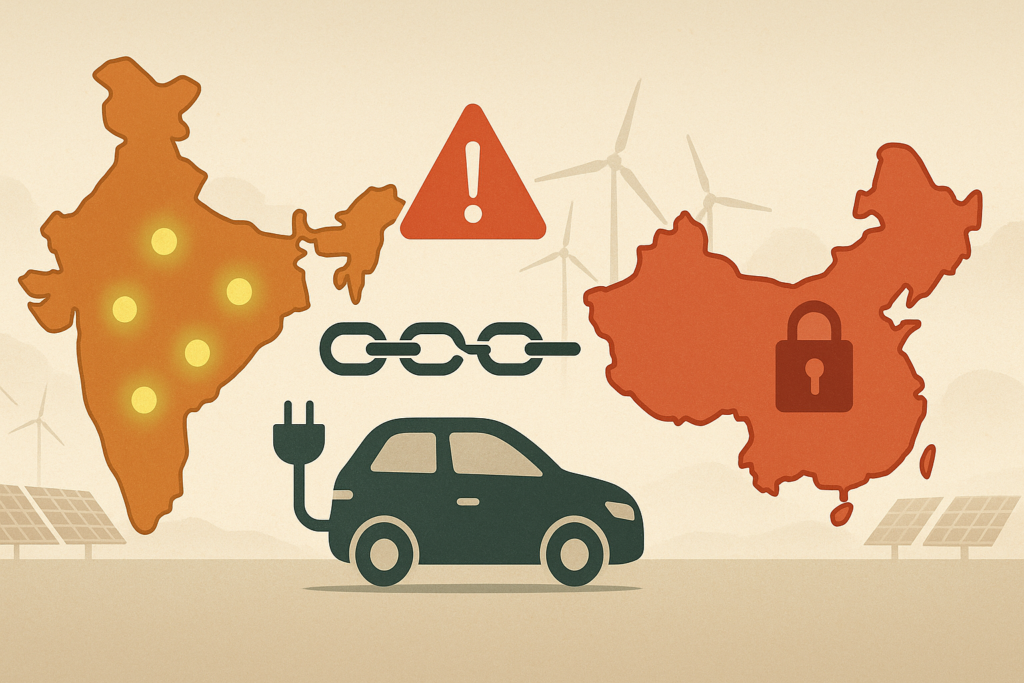
- Despite possessing the world’s third-largest reserves of rare earth elements (REEs), India is now facing a severe supply crisis that threatens to bring its prospering electric vehicle (EV) industry to a standstill.
- Rare earth magnets, particularly an alloy of neodymium-iron-boron (NdFeB), are central to the technology powering modern electric vehicles and renewable energy systems.
- A major reason for India’s underperformance in rare earth mining is policy paralysis and bureaucratic red tape.
Despite possessing the world’s third-largest reserves of rare earth elements (REEs), India is now facing a severe supply crisis that threatens to bring its prospering electric vehicle (EV) industry to a standstill. The immediate trigger is China’s recent export restrictions on rare earth magnets, which are crucial for manufacturing electric vehicles (EVs) and a range of other advanced technologies. With just a month’s worth of stockpiles remaining, Indian automakers are facing the prospect of production lines coming to a sudden halt. While blowing some winds of change, this crisis raises a deeper, uncomfortable question. Why did India, a nation blessed with abundant resources, fail to secure its supply chains? The answer lies in an over-cautionary tale of a nation caught unprepared in the new era of resource geopolitics.
China’s Export Curbs: The Brewing Global Crisis
The rare earth crunch is already having a tangible impact on India’s EV and high-tech sectors. Automakers such as Bajaj Auto and TVS Motor have warned of imminent production cuts if supplies are not restored, and the Federation of Automobile Dealers Associations (FADA) reports that only a third of its members expect sales growth in June. The shortage is not limited to EVs; it also threatens renewable energy, electronics, and defence manufacturing, all of which rely on rare earth materials for critical components. Some companies are considering importing fully assembled motors from China, but this would require significant changes to supply chains and new regulatory approvals, adding cost and complexity.
India’s electric vehicle (EV) industry is facing a severe supply shock after China imposed strict export restrictions in April 2025. These new rules require exporters to obtain licenses, a process that has slowed shipments to a crawl. As a result, Indian automakers are left with only about a month’s worth of rare earth magnet inventory, raising the risk of production halts by July if shipments do not resume. The licensing process is taking at least 60 days, and so far, none have been approved, causing bottlenecks at Chinese ports and threatening to paralyse India’s fast-growing EV sector, which is the third largest in the world.
India’s Rare Earth Reserves: An Untapped Wealth
Ironically, India is not short on rare earth resources. The country holds one of the world’s largest reserves of rare earth elements (REEs), estimated at 6.9 million metric tonnes, primarily in the states of Andhra Pradesh, Karnataka, Odisha, and Kerala. Despite this, India produces less than 1% of the world’s rare earths, with most mining and processing handled by the state-run IREL (India) Ltd. The United States, with much fewer REE reserves, mines 20 times more than India. Private sector involvement has been minimal, and technological as well as infrastructural limitations further constrain domestic production. Most of India’s rare earth output is limited to light REEs, while heavy REEs like dysprosium and terbium, which are critical for high-performance magnets, remain in short supply, largely due to a lack of mining.
India holds one of the world’s largest reserves of rare earth elements (REEs), estimated at 6.9 million metric tonnes, primarily in the states of Andhra Pradesh, Karnataka, Odisha, and Kerala.
India’s Babudom: Policy Paralysis and Bureaucratic Hurdles
A major reason for India’s underperformance in rare earth mining is policy paralysis and bureaucratic red tape. India’s predicament is rooted in years of complacency and missed opportunities. Despite holding significant reserves, the country has consistently failed to develop a robust domestic rare earth industry. Restrictive regulations, lack of incentives for private investment, and the convenience of cheap imports from China all contributed to neglect. Mining of monazite, the main source of rare earths, is classified alongside atomic minerals due to its thorium content, subjecting extraction to strict regulatory controls and limiting operations primarily to government agencies. Obtaining mining permits and environmental clearances is a slow and complex process, often taking years. The amendments to the Mines and Minerals Act (Development and Regulation) promise change. The amendments revise the classification and exploration stages for rare earth element (REE) deposits in pegmatites, reefs, veins, pipes, carbonatites, and other alkali igneous rocks, categorised as G4 (reconnaissance), G3 (prospecting), G2 (general exploration), and G1 (detailed exploration). However, most of the sector’s technological and infrastructural capabilities remain underdeveloped, discouraging private investment and innovation.
Overreliance on China: Why India Didn’t Wake Up?
For years, Indian manufacturers have preferred importing rare earth magnets from China due to their low cost and easy availability. Simply because the entire world is also highly reliant on China, accounting for 64% of Global Permanent magnet exports. However, this overreliance has now become a critical vulnerability, with over 80% of rare earths used in India’s value-added sectors, particularly permanent magnets for electric vehicles (EVs) and clean energy, being imported from China. Even after witnessing China’s use of rare earths as a geopolitical tool in 2010 and again in 2020, India’s policy response was slow and fragmented, only recently opening the sector to private players and international collaboration. India’s focus remained on raw material extraction, with little attention paid to building processing capacity or supporting downstream industries. The current crisis has compelled automakers and industry bodies to seek urgent government intervention and explore alternative sourcing strategies; however, options remain limited in the short term.
Role of Rare Earth Magnets in EVs and Renewable Energy
Rare earth magnets, particularly an alloy of neodymium-iron-boron (NdFeB), are central to the technology powering modern electric vehicles and renewable energy systems. In EVs, these magnets are used in the main drive motors, where their high magnetic strength enables compact, lightweight, and efficient designs. Each EV typically contains 2 to 5 kilograms of these magnets, not only in the drive motor but also in auxiliary systems like power steering, brakes, and sensors. NdFeB magnets, often enhanced with dysprosium or terbium for heat resistance, provide the torque and power density needed for high-performance electric motors.
In renewable energy, neodymium magnets are used in generators to efficiently convert wind energy into electricity. Wind turbines, which form a significant part of this renewable mix, depend on high-performance rare earth magnets for direct-drive generators, enabling greater efficiency, lower maintenance, and higher reliability. These magnets allow for direct-drive systems, eliminating complex gearboxes, which in turn increases efficiency and reliability while reducing maintenance, making rare earth magnets indispensable for clean energy and electric mobility, supporting the global shift toward sustainability. This is especially critical as India’s non-fossil power generation capacity is set to touch 50% by December 2025, a milestone that puts India among the world’s leading clean energy nations. As India’s renewable energy installations surge past 226 GW and approach the 500 GW non-fossil target for 2030, the demand for rare earth magnets is set to rise sharply, making them a cornerstone of the country’s clean energy transition.
Hyderabad-based Midwest Advanced Materials Private Ltd (MAM) has invested 1000 crores to become the first Indian firm to manufacture rare earth magnets for EVs commercially.
Domestic Manufacturing: MAM Hyderabad’s Breakthrough
Hyderabad-based Midwest Advanced Materials Private Ltd (MAM) has invested 1000 crores to become the first Indian firm to manufacture rare earth magnets for EVs commercially. Backed by the Department of Science and Technology and technology transfers from the Nonferrous Materials Technology Development Centre, MAM is establishing an integrated production system for neodymium-based magnets. The plant will start with an initial capacity of 500 tonnes per year, with plans to scale up to 5,000 tonnes annually by 2030. This facility will use raw materials supplied by IREL, making the project financially viable and strategically important for India’s e-mobility and renewable energy sectors. Commercial production is expected to begin within six months, marking a crucial step in reducing India’s dependence on Chinese imports and strengthening the domestic supply chain.
Immediate and Long-Term Solutions: Government Response
In response to the crisis, the Indian government is rolling out both immediate and long-term solutions. In the short term, authorities are seeking emergency imports from alternative suppliers such as Vietnam and the US and fast-tracking the commercialisation of homegrown magnet-making technology. The government is also considering Production Linked (fiscal) Incentives (PLI) to encourage domestic manufacturing, including subsidies to bridge the price gap with Chinese imports. For the long term, the National Critical Mineral Mission (NCMM) was launched in April 2025 to boost self-reliance in sourcing, processing, and recycling critical minerals, including rare earths. The Geological Survey of India has been tasked with 1,200 exploration projects through 2031, and more than 100 critical mineral blocks are set to be auctioned. The mission also focuses on setting up mineral processing parks, investing in R&D, and forming international partnerships for technology transfer. While these measures are ambitious, experts caution that building a resilient supply chain will take several years and require sustained commitment from both the public and private sectors.
On 14th June 2025, India made a decisive policy move by instructing state-run IREL to halt a 13-year-old rare earth export agreement with Japan, prioritising domestic needs and aiming to reduce reliance on China. This shift is significant, as IREL had been supplying over 1,000 metric tons of rare earths annually to Japan, accounting for about a third of its total production. The government is also seeking a corporate partner to help produce rare earth magnets for the automotive and pharmaceutical sectors and is firming up plans to offer incentives for companies setting up processing and magnet manufacturing facilities in India.
On 14th June 2025, India made a decisive policy move by instructing state-run IREL to halt a 13-year-old rare earth export agreement with Japan, prioritising domestic needs and aiming to reduce reliance on China.
Latest Developments: Policy Shifts and Industry Moves
India is doing all it can to avoid the crisis. As the world’s clean energy and EV ambitions grow, India is keen to ensure it isn’t caught off guard by global disruptions. New guidelines for rare earth exploration were announced in mid-June, introducing stricter protocols for exploration and extraction, and aiming to boost precision and investment in India’s mining sector. While these quick fixes may satiate the problem, the number of Indian companies awaiting Chinese export licenses for magnets has doubled in just two weeks. With no approvals granted as of mid-June, stocks are expected to run out by early July if the situation persists.
India is taking meaningful steps to reduce its reliance on China for rare earth supplies by reaching out to new partners like Australia, Argentina, Brazil, and Chile. These talks are not just about securing raw materials; they’re about building a more resilient and reliable supply chain for the future. Alongside these international efforts, India is also pushing domestic initiatives, like requiring all mines to check for critical minerals and boosting lithium imports from Chile, to strengthen its homegrown manufacturing ecosystem. However, these developments underscore both the urgency and complexity of India’s rare earth conundrum. As India races to secure its supply chains and build up domestic capabilities in the face of global shortages and geopolitical headwinds, showing the will to change but asking more to be done.
Abhinav is an accomplished Engineer, Technical Writer and consultant, who has worked for prestigious Navratna PSUs of India. He is an expert on matters related to Defense and Technology. Views are personal.
